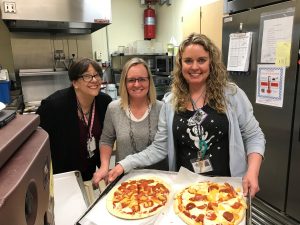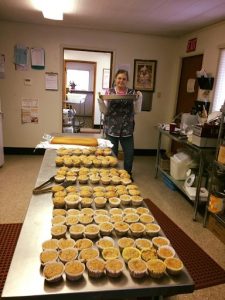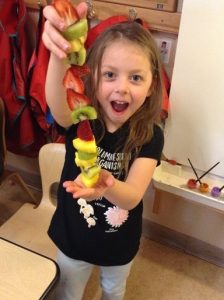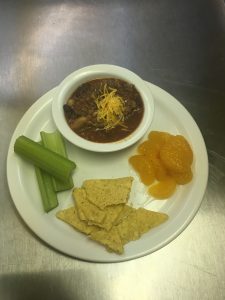Beets and chickpeas: They don’t sound like usual preschool favorites, but that is what is on the menu for Sound to Harbor Early Learning Programs’ ECEAP and Head Start preschool classrooms across the region. And the kids love it.

“We try to focus on really nutrient-dense foods, and getting that exposure to children at a very young age,” says Patricia Barret, food services manager for Sound to Harbor. “Evidence shows that children in preschool who are given opportunities to try new and healthy foods actually make lifelong healthy choices. So, it’s my mission to expose them to a variety of healthy things, even beyond what they will see in the salad bar in K-12 schools.”
“We have to balance healthy, nutrient-dense meals with a child-friendly palate,” she adds. One of the ways Sound to Harbor accomplishes this is by making a lot of items from scratch, avoiding a lot of the added salt and sugars that come along with canned or heavily processed foods. For example, Sound to Harbor makes a homemade tomato soup. Because the soup is homemade, it may not look quite like canned tomato soup that students are used to having, so Sound to Harbor serves the healthier homemade option alongside a familiar grilled cheese sandwich.
Sound to Harbor also makes favorite foods healthier. Macaroni and cheese is very popular with preschoolers. “We incorporate pureed butternut squash, which gives that orange color that many children are familiar with, but it also boosts the vitamin and mineral content and adds additional fiber,” Barret explains. All of Sound to Harbor’s muffins are made in house, using a base made with oat bran and whole-wheat flour. One of the most popular muffins is the beet muffin. The muffin uses the nutrient-dense muffin mix, unsweetened cocoa powder, and beets to add a touch of sweetness. To the children, it looks like just another chocolate muffin. “And they love them,” she adds.

Though Sound to Harbor incorporates vegetables in unexpected places, they never really hide the vegetables from their students. “We want students to recognize healthy foods and know that healthy things can taste good, and we don’t want to trick them,” says Barret. That means that healthy ingredients are usually named in the food, or discussed during meal and snack time.
Sound to Harbor serves 900 children every school day. Barret helps plan and coordinate meals and snacks for all of those children. She also helps work a nutrition curriculum into the classroom. Here are just a few tips from Barreton how you can make healthy food more enticing to young children:
Give the Food a Fun Name
When Sound to Harbor students were introduced to hummus, the “Avengers” film was big in theaters. So they served hummus, made with young green chickpeas, and called it “mean green hummus.” Students learned that hummus is something healthy that would help them grow big and strong like the Hulk.
Serve a New Healthy Food Alongside Something Familiar
Sound to Harbor serves their homemade tomato soup alongside grilled cheese. When they serve “mean green hummus,” it comes with tortilla or pita chips. Familiar foods are comforting, especially to young children, and they are more likely to try new things when it’s paired with something they recognize.

Encourage ‘Try Me’ Bites
Continued exposure to healthy foods allows students to try new foods. It can take as many as 10 or 20 tries before a new flavor becomes familiar to a child. Forcing a child to eat something generally results in a negative association with the healthy food, or even worse, a negative association with all new foods. Instead, Sound to Harbor encourages try me bites, or adventure bites, and children are allowed to discover that they enjoy the healthy food.
Invite Children to Help Prepare Meals
Preschool children love to help prepare food, even if it’s just to help prepare a side dish like a salad. During a Sound to Harbor study, when children were learning about trees, the students helped prepare “tree fruit salad.” The salad contained fruits that only came from trees. Students enjoyed making part of the meal, eating the meal, and they were able to incorporate it into their learning.
A big concern these days is food allergies, restrictions or special dietary needs. Sound to Harbor seeks to empower students by helping them advocate for themselves at mealtime. All of Sound to Harbor meals are served family-style around a table. To ensure that students with special dietary needs are accommodated, every student has a placemat which lists their special dietary concerns. This helps remind both the student and teacher about those special dietary considerations. “Especially in regards to anaphylactic reactions, it is important for a student to learn what they can and cannot have because there won’t always be someone there to remind them as they get older,” adds Barret.
“We want all children to feel included, so if they have a special meal that includes different ingredients than their classmates, it will look similar to what their classmates have,” says Barret, “and they will still be included in choosing from the side dishes that are offered at the meal, passing the grapes or carrots around the table.” Sound to Harbor accommodates many different diets needs, including gluten-free, dairy-free, low-FODMAP, vegetarian, and no beef or no pork religious accommodations.

Sound to Harbor students receive a combination of breakfast, lunch, and one or more snacks, depending on the length of their school day. All meals are supervised by Child and Adult Care Food Program (CACFP), which does regular audits to ensure that students are receiving healthy and nutritious meals which meet or exceed USDA guidelines. All of their menus are also reviewed by a dietician.
Sound to Harbor also incorporates local foods every time they can, including Shepard’s Grain muffin mix which is grown in eastern Washington. Many of their foods come from Washington or Oregon. “Mean green hummus” is made from young chickpeas grown in eastern Washington. The strawberries they serve come from Skagit County. They get yogurt from Auburn. “We really do try to look for things produced here in Washington.”
If you have a child that’s ready for preschool, head over to Sound to Harbor’s website to see if they qualify for one of Sound to Harbor Early Learning Programs Head Start or ECEAP classes.
Sponsored











































